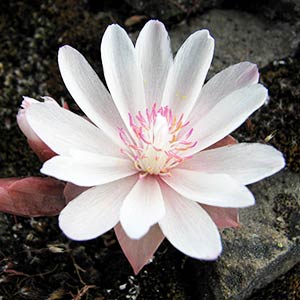Lewisia rediviva
Lewisia disepala
bitter root, bitterroot lewisia, resurrection flower
Yosemite lewisia
gradually ramified distally.
gradually ramified distally.
procumbent to erect, 1–3 cm.
erect, 0.5–3 cm.
basal leaves withering at or soon after anthesis, sessile, blade linear to clavate, subterete or grooved adaxially, 0.5–5 cm, margins entire, apex obtuse to subacute;
cauline leaves absent.
basal leaves withering at or soon after anthesis, sessile, blade linear to slightly clavate, terete, 0.8–2 cm, margins entire, apex obtuse;
cauline leaves absent.
with flowers borne singly;
bracts 4–7(–8), whorled, subulate to linear-lanceolate, 4–10 mm, margins entire, apex acuminate.
with flowers borne singly;
bracts 2–4, proximal in 1 pair, ovate to lanceolate, 2–3 mm, margins entire, apex acute.
pedicellate, disarticulate in fruit;
sepals (4–)6–9, broadly elliptic to ovate, 10–25 mm, scarious after anthesis, margins entire to somewhat erose, apex obtuse to rounded;
petals 10–19, usually rose to pink, sometimes lavender, sometimes with paler or white centers, or wholly white, elliptic, oblong, or narrowly oblanceolate, 15–35 mm;
stamens 20–50;
stigmas 4–9;
pedicel (1–)3–15(–30) mm.
sessile to subsessile, disarticulate in fruit;
sepals 2, broadly obovate to broadly ovate, 7–8 mm, scarious at anthesis, margins entire, apex rounded or sometimes emarginate;
petals 5–8, pale rose-pink, oblanceolate to broadly obovate, 13–18 mm, apex obtuse;
stamens 1–15;
stigmas 4.
5–6 mm.
6–25, 2–2.5 mm, shiny, minutely papillate.
11–15, 2.8–3.5 mm.
= 26, 28.
Lewisia rediviva
Lewisia disepala
Varieties 2 (2 in the flora).
Native Americans commonly ate the boiled roots of Lewisia rediviva.
(Discussion copyrighted by Flora of North America; reprinted with permission.)
Of conservation concern.
Lewisia disepala is known only from scattered localities in the southern Sierra Nevada.
(Discussion copyrighted by Flora of North America; reprinted with permission.)
1. Basal leaf blades clavate to narrowly oblanceolate, grooved adaxially; sepals 10-12(-15) mm; petals 15mm; stamens 20-30 | var. minor |
1. Basal leaf blades linear, subterete, not grooved adaxially; sepals 15-25 mm; petals 18-35 mm; stamens 30-50 | var. rediviva |
- Local floras:
BC,
CA,
OR,
WA
- Local Web sites:
CalFlora,
CalPhotos,
Flora NW,
PNW Herbaria,
Turner Photog.
WildflowerSearch
iNaturalist (observations)
USDA Plants Database
- LBJ Wildflower Center
- SEINet
- Plants of the World Online
- Encyclopedia of Life
- Wikipedia
- Google Image Search


